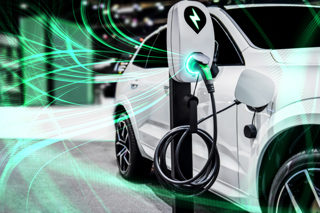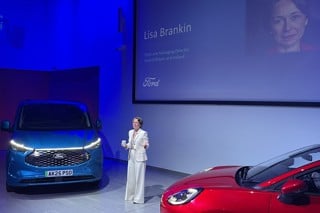Vendigital’s Sheena Patel argues that the industry needs to come together to outline and define higher levels of standardisation, something that will not only benefit consumers by providing more options when it comes to running and maintaining vehicles, but will also benefit OEMs by increasing uptake.
Used EVs are now attracting residual values close to those of used ICE vehicles, leading some to predict a surge in uptake could be on the way.
However, barriers to sale remain, with many consumers still concerned about access to charging infrastructure, total running costs including replacement parts and servicing, and car insurance.
With further challenges including international competition threatening to flood the UK market, working with the government and near shoring the supply chain ecosystem will be the key to seizing the next stage of the EV opportunity.
As political pushback against green initiatives continues to present risks on a global scale, OEMs including UK-based manufacturers selling outside of the UK, continue to be challenged on scheduling and production planning, particularly where different consumer bases and political influences are driving large variations in demand.
This ultimately has a knock-on effect on the speed-to-market, slowing down supply chain maturation and saturation, keeping technology costs elevated and lengthening the rate of return on investments.
Net Zero
However, with the Labour government’s focus on decarbonisation and net zero, the industry could soon see renewed incentivisation as electrification targets are brought back to 2030.
Currently, new EVs typically remain more expensive than traditional ICE vehicles, raising concerns about the social exclusivity that this presents to consumers across different socio-economic positions.
While the second-hand market is beginning to show signs of parity, it does still come with challenges in vehicle aftermarket services.
For example, consumers have long enjoyed the market saturation of ICE technology, and the regulation and standardisation of parts and components have given ease of accessibility to maintain vehicles through both OEM and independent service providers.
EV aftercare, however, still very much relies on the OEM and typically comes in at a significantly higher cost. This is intensified by OEMs developing their intellectual property with limited industry standardisation: particularly around high-cost items such as batteries and inverters.
As such, with EV technology still relatively new (at least outside of China) and continuing to evolve at a rapid pace, many independent businesses simply won’t yet have the information or capabilities needed to service, repair, or maintain a broad range of underpinning software applications for EVs, leading to low levels of competition with OEMs.
Ownership Costs
As the industry looks to continue developing affordable EVs, uptake could still weaken due to other costs associated with ownership and a lack of compelling and accessible total solutions for the consumer.
Despite these challenges, the discussion around EVs continues to evolve, with some breakthrough in uptake as more corporate schemes offer EVs to employees in a practice that is not only broadening the accessibility threshold, but is simultaneously changing perceptions around how easy they are to run.
While myths certainly remain, these seem to have shifted away from the functionality and reliability of the EV itself towards the wider ecosystem that surrounds it: namely the lack of charging infrastructure and questions around access to competitively priced servicing and repairs.
If infrastructure provision is not increased in line with the growing number of used EVs hitting the roads, the market could risk stagnation before this new area is able to take off.
Creative solutions are emerging across countries to tackle this. For example, Norway and China have implemented battery swapping stations that allow drivers with different ownership agreements to easily swap power packs, alleviating the strain on the grid infrastructure.
However, swapping stations are brand-led and in order for solutions like these to really take-off, the industry needs to come together to outline and define higher levels of standardisation that will not only benefit consumers by providing more options when it comes to running and maintaining vehicles, but will also benefit OEMs by increasing uptake.
Aftermarket Services
In the face of low demand forecasts, the burgeoning second-hand EV market means it is more vital than ever for OEMs to continue to invest to grow their consumer base, and taking an urgent look into their aftermarket services will be key.
Where ICE vehicle components have been matured to the point that a thriving and competitive commodity market is in place, EV components continue to largely remain in the development phase of new product introduction, with little in the way of non-branded aftermarket parts for on-going maintenance.
Supply chain collaboration both vertically and horizontally, as well as with government bodies, therefore needs to be closer to achieve the successful transition to EVs that must be available to everyone.
In order to stay close to consumer appetite and develop technology that is affordable and green, data will play a huge part in this new portfolio. With the introduction of EV software and in particular, battery management systems, there will be no shortage of data points to measure in-field vehicle performance and driving styles.
OEMs can leverage this information to enhance product performance and ultimately customer experience in this new portfolio of vehicles, and it will additionally help them to better understand future aftermarket requirements to meet consumer need.
Furthermore, with EVs being driven by net zero and sustainability ambitions and consumers increasingly being switched on to greener solutions, developing a product that encompasses those principles from design to end of life is vital.
Supply Chain Data
At a vehicle design and production level, OEMs and suppliers would be prudent to collect and manage supply chain data now, in advance of legislation being developed, particularly around battery passports.
This data will be key in managing a circular economy and second life that encompasses the entire value chain, in which materials can be repurposed or recycled to reduce waste and reliance on precious natural resources.
Ultimately, the UK EV market remains at a difficult juncture, with high levels of investment compared to relatively low levels of uptake.
However, if activity is underpinned by tangible support from policymakers and governing bodies, and by thoughtfully curating an industry ecosystem that will build on the increased interest in the used EV market, there is hope that the industry can hold a strong position and keep the UK’s automotive legacy alive.
With a closing window and outside competition looking to tap into the market, the industry must act now with purpose and pace.
Sheena Patel is a director at management consultancy Vendigital




















Login to comment
Comments
No comments have been made yet.